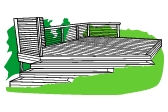
Freestanding decks are decks that don’t attach directly to your home or any other fixed structure. Freestanding decks offer a good way to create a stable living area separate from your house.

What are freestanding decks?
A freestanding deck is any deck or platform not attached to the house. Freestanding decks typically have no roof overhead, but may have several paths leading up to them. They may require different kinds of maintenance to shaded or water exposed decking, as they will spend a great deal of time exposed to the sun with no moisture. These decks can be built in virtually any size and shape, to accommodate for any area in which you might like to build one.
Where and how are freestanding decks used?
A freestanding deck can be often be a good choice on sloping properties, as it provides a stable, level area on which to walk. This helps to expandyour useful backyard. Freestanding decks can also allow for a tree to come up through the middle or be built around existing trees, providing both natural shading and something good to look at.
Freestanding decks make for interesting features in designer backyards, floating islands of space on which to relax and soak up the sun, host barbecues and guests, or simply to provide access to views that may otherwise be hidden or unreachable.
How are freestanding decks constructed?
The posts for the deck are concreted in and allowed to set. If working on a slope, always be mindful of the level of your deck and allow extra length on the posts to compensate. The bearers are affixed to the poles and the joists are spaced in between the bearers to brace them and lend extra strength to the structure. The decking is then overlaid on top. With lower freestanding decks, the sides are usually also covered in decking to hide the joinery beneath.
Bushfire classifications and freestanding decks
In some cases, the special BAL requirements for decks in bushfire prone areas won’t apply to freestanding decks, provided that they’re far enough away from your home and built within certain guidelines. Generally speaking, if your deck is more than 6m away from your home and is classified under the BCA’s building classification scheme as a ‘Class 10’ structure, it may be exempt from the special requirements for other types of decks in bushfire prone areas.
Check with your local building authority for the proper advice for your circumstances before building in bushfire prone areas.
|
Advantages
|
Disadvantages
|





